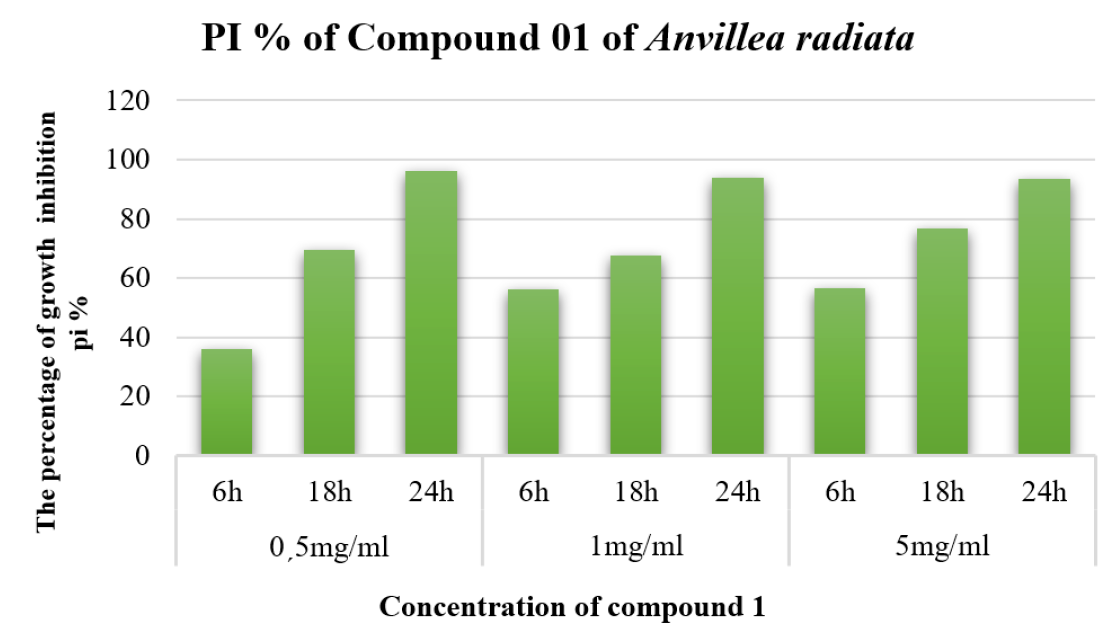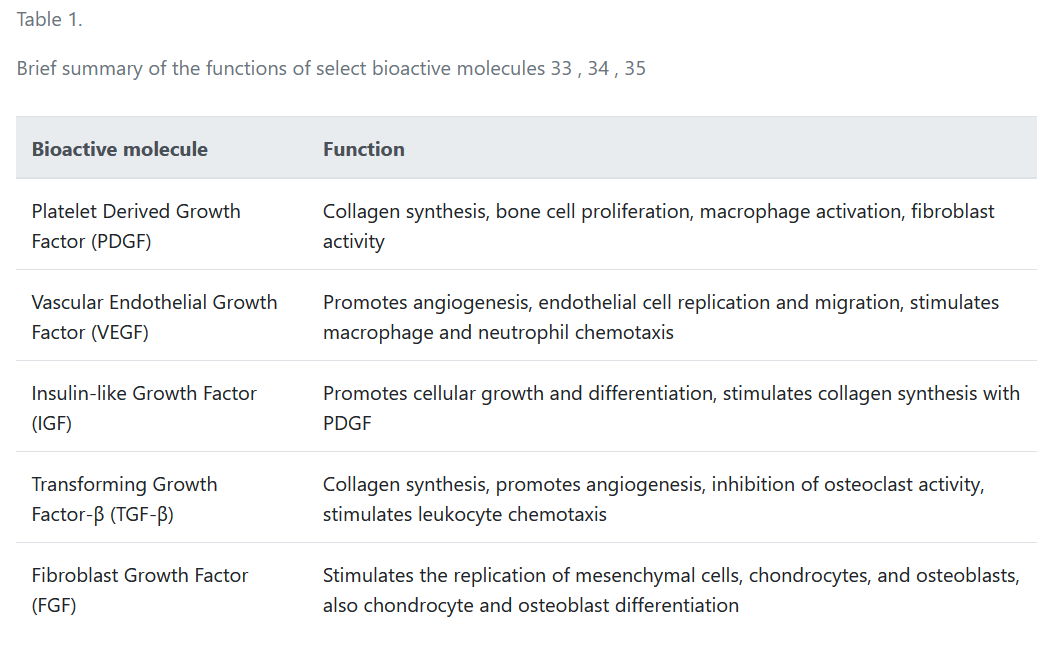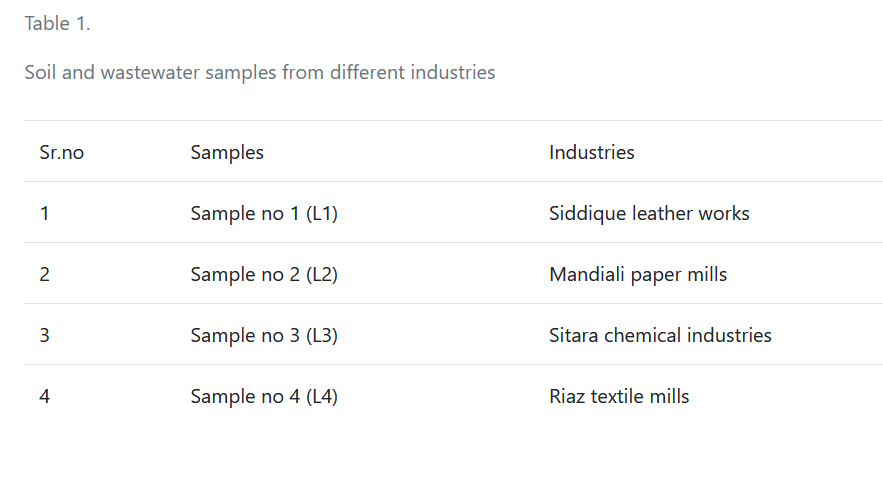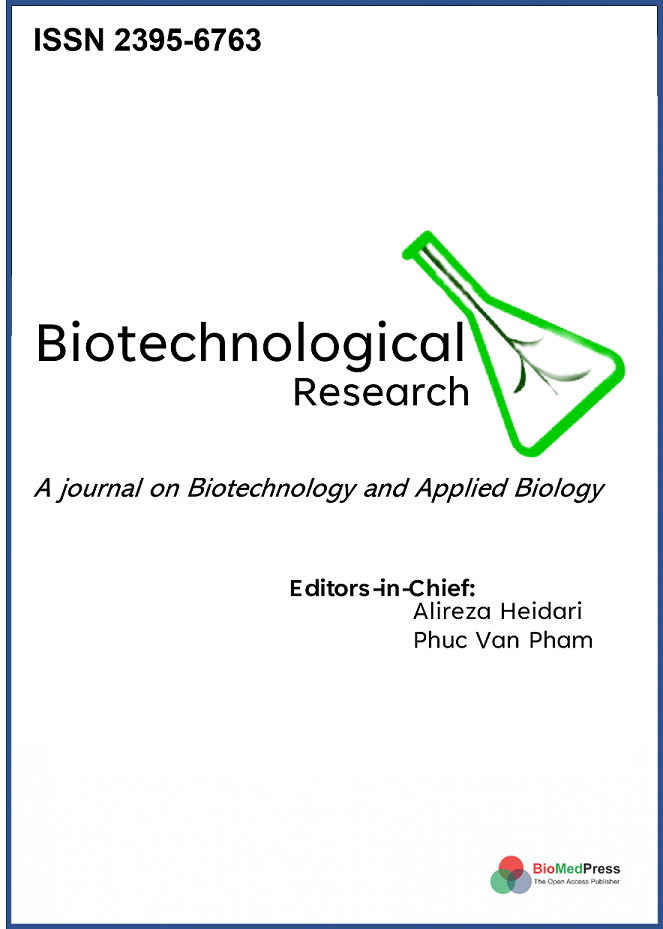Featured Articles
latest articles

Anti-Giardia Activity of a methanol extract of Anvillea radiata
by Roucham
Z.,
Cheriti
A.
Summary: This study aimed to evaluate the antiparasitic activity of Anvillea radiata plant extracts from the traditional pharmacopoeia by searching for new antiparasitic molecules. It seemed important to us to explore the nature of the natural antiparasitic substances in some Asteraceae of traditional Saharan medicine.

Efficacy of Activated Autologous Platelet-Rich Plasma in The Treatment of Diabetic Foot Ulcers: An Evidence-Based Brief Literature Review
by Fibrini
D.,
Hanafie
A.
Summary: Diabetic foot ulcers (DFUs) present as a debilitating complication of diabetes which approximately affects 6.3% of the global population with significant mortality and morbidity consequences. While one-third of the total cost of diabetic care goes to DFU treatment, 20% patients have unresolved ulcers, while 40% experience recurrency within one year. To improve outcomes in DFU care, activated autologous platelet-rich plasma (aaPRP) is one of the adjuvant therapies proposed. Containing various bioactive proteins such as growth factors and cytokines, it possesses regenerative, antioxidative, anti-inflammatory, and antimicrobial qualities. Furthermore, its autologous nature, which also makes it a highly safe treatment modality, is also promising. In this review, we shortly discuss the pathogenesis of DFUs and how aaPRP may tackle the key players in DFU pathogenesis to improve wound healing outcomes. We also briefly describe its method of isolation and the current views on aaPRP from an authoritative source. Lastly, we summarize the existing evidence for the utilization of aaPRP in the treatment of DFUs.

Assessment of metal-reducing bacteria residing in industrial wastewater: a bacterial-based bioremediation approach
by Sajid
T.,
Aslam
R.,
Kazmi
A.,
Kazmi
A.,
farooqi
S.,
Tariq
A.,
Muhammad
A.
Summary: Metals are required in minor amounts in the human body to perform vital functions, but beyond that level, they become toxic and cause many harmful effects. At present, polluted water is a large source of these heavy metals inside our body. Bioremediation is one of best treatments for the removal of these heavy metals from water. Objectives: The main objective of the current study was to isolate metal-reducing bacteria from soil and wastewater samples from different industries. Furthermore, the metal reducing potential of the bacteria was also evaluated under various environmental conditions (pH, temperature, incubation time, and UV exposure).

Toward a Diagnostic Test for Human African Trypanosomaisis
by JAZTLAU
T.,
SCOTT
T.,
FONTUS
M. F.
Summary: Human African Trypanosomiasis (HAT), caused by Trypanosoma brucei, T. brucei, disproportionately affects inhabitants of Sub Saharan Africa. T. brucei gambiense and T. brucei rhodesiense are the only strains that produce illness in humans. The purpose of this project is to determine if T. brucei Superoxide Dismutases, TbSODs, can be used as a biomarker for positive diagnosis of HAT. The hypothesis to be tested is if a rat is infected with T. brucei, then it will have traces of tbSOD in its bloodstream because as the rat’s immune system fights T. brucei infection some parasitic cells will lyse excreting many internal proteins including SOD into the bloodstream. Our methodology will consist of developing a modified version of the Villagran et al 2005 protocol whereby a series of blood tests will be performed on infected rats. If the blood tests positive for TbSOD then it is assumed that they have a strain of T. brucei. Finally, after confirming the presence of TbSOD, we will use ELISA to establish a correlation between TbSOD’s level and the degree of progression of the infection.
Antibacterial Activity of Bio Synthetic Silver Nanoparticles Against Escherichia Coli And Salmonella Typhimurium Using Moringa Oleifera Leaves Extract
by MOHAMED
A
MOHAMMED
A.,.
MAHROUS
H
Summary: Objectives: Antibacterial activity of bio synthetic silver nanoparticles against Escherichia coli (E. coli) ATCC 8739 and Salmonella typhimurium (S.typhi) ATCC 14028 using Moringa oleifera leaves extract was investigated. Materials and Methods: Prepared silver nanoparticles were characterized by using different techniques included: Ultraviolet Visible Spectroscopy (UV-VIS spectra analysis), Fourier transform infrared spectroscopy (FTIR) and Transmission electron microscope (TEM). The comparison between the antibacterial activities of the concentration 100 µg/ml of bio synthetic silver nanoparticles using Moringa oleifera leaves extract and 100 µg/ml of silver nitrate solution tested against E. coli reference strain ATCC 8739 and S. typhi ATCC 14028 was evaluated by using agar diffusion assay method. Results: FTIR analysis was showed the reduction action of Moringa oleifera leaves extract to form Silver Nanoparticles. TEM shows a dispersion of nanoparticles in a range (15.22 nm – 29.45) by using Moringa oleifera leaves extract. The antimicrobial activity of the concentration 100 µg/ml of synthetized silver nanoparticles was approved against E. coli reference strain ATCC 8739 by showing zone of inhibition against E. coli equal to 18 mm, while 100 µg/ml of the silver nitrate solution showed zone of inhibition against E. coli equal to 17 mm. While The antimicrobial activity of the concentration 100 µg/ml of synthetized silver nanoparticles which tested against S.ty phi reference strain ATCC 14028 by showing showed zone of inhibition against equal to 21 mm, while 100 µg/ml of the silver nitrate solution showed zone of inhibition against S.typhi equal to 15mm
In Vitro Propagation of Zingiber Officinale Rosc
by S
H.,
K
R.,
R
W.,
RD
F.,
CT
W.,
CK
R.
Summary: Ginger (Zingiber officinale Rosc.) has become more popular in recent years because of its low toxicity and its broad spectrum of biological and pharmacological applications. These applications include antitumor, antioxidant, anti-inflammatory, antiapototic, cytotoxic, antidiabetic, anti-proliferative and anti-platelet activities. Traditionally, ginger can be propagated by using the fingers of the ginger rhizomes however early in the crop, disease can cause severe losses. Ginger propagation is usually performed with rhizome which depends on the availability of good quality seed rhizome. Alternatively, tissue culture technology can be used for the propagation of ginger. Tissue culture ginger has been considered vital for germplasm conservation and the resuscitation of the ginger industry in Jamaica in response to the ginger rhizome rot disease. Research from trials (unpublished) performed at the Scientific Research Council (SRC), Jamaica, indicated that the yellow variety of the Jamaican ginger have a lower multiplication rate than the Jamaican blue variety. Micropropagation of the Jamaica yellow explants was done on three growth media types. Explants were cut to approximately 1cm in height and transferred to media (S, F, M). The shoots developed in vitro were separated and subcultured on same medium for multiplication and rooting over a 6-week period. Growth parameters were evaluated during the course of the study. These included number of shoots, height of shoot and number of leaves. This study aims to investigate the performance of Jamaica’s yellow ginger variety on different nutrient media. Media M appears to be the most effective for the growth and multiplication of Jamaican yellow ginger variety when compared to Media S and F. However, there remains a need for further research in improving media M to obtain optimal growth of ginger explants in vitro.
Approaches from Resveratrol Activities on Central Nervous System Inflammation
by DA SILVA
T., F.,
DOS SANTOS TELES
S., S.,
DE ASSIS
T., S.,
OLIVEIRA JUNIOR
M. S.
Summary: Neuroinflammation is a common protective mechanism in homeostasis breakdown processes on the central nervous system. The prolongation of this process is responsible for the primary immune response of many neurodegenerative diseases. Understand these mechanisms has brought more effective alternatives to the scientific literature, on development of more effective pharmacological interventions. However, allopathic means of intervention to inflammation are sometimes insufficient to promote a good prognosis and reversal of the inflammatory process. Resveratrol is a polyphenol from the stilbene class, that has shown anti-inflammatory characteristics in several disease study methods, mainly in the ability to generate neuroprotection in neuroinflammatory damage models, reducing the production of pro-inflammatory cytokines and allowing survival, as well. Neuronal regeneration activity also as saw mainly through neurotrophin modulation and antioxidant activity. Resveratrol has shown promise in reversing neuronal death, an important activity in the face of the special needs for new drugs, capable enough to promoting better survival for patients with neurodegenerative diseases. In this review, it’s possible saw that Resveratrol has significant characteristics for future use in the treatment of neurodegenerative diseases.
Detection of Sole and Clonal Aneuploidy in Hematologic Malignant Diseases
by P. SHAH
N.,
S.SHAH
P.,
H.BHATT
N.,
MISTRY
K.,
DOMINIC
J.,
KANSARA
M.,
HAKIM
S.,
C. SHAH
S.,
V RAO
M.
Summary: Numerical chromosomal aneuploidy has diagnostic and prognostic value in detection of cancer. Hence, the study was undertaken in leukemic cases in our diagnostic laboratory. Analysis of 211 leukemic blood samples from referral cases of Neuberg Supratech Referral Laboratory (NSRL), Ahmedabad, India, since 2017 to 2019 using WHO protocols for chromosomal study. Detection of 23 cases were obtained (23/ 211: 11%) with this condition. Trisomy 8, 11, 13, 21 and monosomy 7 contributed to 18 cases (18/ 23; 78%) with 5 clonal anomaly (5/23; 22%). Four clonal patients were +8, +21 and +21, XXY and -7 with XY cells. Another karyotype with 48,XY,+8,+19/ 47,XY,+8 was detected which seems to be a new cytogenetic anomaly in the literature causing haematologic neoplasms in this cohort.
A Multi-Level Layout Algorithm for Identifying Highly Interacted Human Protein Complexes and Various Protein Pathways
by E.S
D.. S.
Summary: Discovering highly interacting proteins and its pathways is a challenge for computational biologists. Identifying interactions among proteins and its pathways has been found to be useful for drug development. In our study, we collected data of 40,788 protein - protein interactions from HPRD and IntAct. This pooled off data was loaded into cytoscape (version 2.63) to visualize the human interactome network through the grid layout method. By using Connected Component (CC) algorithm, the largest and the highly connected human network were found. From 36,945 binary protein – protein interactions, 89 highly connected modules were selected, which are of high score value. The total numbers of proteins in each of the 89 modules were found out. The proteins from all the 89 clusters were classified into 2 categories - normal and diseased pathways. From all these 89 clusters, 1350 proteins were obtained and were unique, of which 374 proteins are in the normal pathways and 976 proteins in diseased pathways. But 976 proteins were found in both normal and diseased pathways. Further computational studies can help to understand the changes that occur in the proteins to become in the diseased pathways.
Phytochemical and Anti-nutritional potentials of leaves and stem-bark of Cathormion altissimum (Hook.f.) Hutch. & Dandy
by YOUKPARIGHA
F., O.,
NYANANYO
B., L.,
OYEDEJI
A. A.
Summary: The phytochemical and anti-nutritional constituents of leaves and stem-bark of Cathormion altissimum (Hook.f.) Hutch & Dandy was evaluated. The leaves and stem-bark of Cathormion altissimum used for this study were obtained from several communities in the eight local government area of Bayelsa State, Nigeria. The plant was qualitatively and quantitatively analyzed for some phytochemical and anti-nutrients constituents. The results of quantitative analysis showed that alkaloids, saponins, flavonoids, glycosides, phytate, tannins, oxalate and phenols concentrations were 8.04%, 7.7%, 6.94%, 0.432mg/kg, 0.0917%, 2.684%, 71.0 mg/g and 1002.88 mg/kg, respectively in the leaves, and 3.36%, 5.0%, 3.36%, 0.432mg/kg, 0.0917%, 1.026%, 18.10 mg/g and 62.88 mg/kg, respectively in the stem-bark. The qualitative results showed that saponins in both plant parts was very highly present, flavonoids in leaf and tannins in stem-bark were highly present, while terpenes, steroids, phenol in both plant parts and flavonoids in stem-bark and tannins in leaf were fairly present. The study showed that the leaf and stem-bark of the plant has pharmacological potentials against different diseases. While the phytate and oxalate suggests that the plant could be toxic over a prolonged period of use. As such, there is the need for research to be carried out to evaluate the concentration of the anti-nutrients that could be toxic to humans, and therapeutic properties of both plant parts.
Detection of Hemolytic Activity of Aeromonas sp Isolated from Water Samples of Coastal Area, Kochi
by ASHITH
V.,
DEEPTHI
C.,
JOSEPH
R., M.,
RAMASWAMY
A.,
VIVEKANANDHAN
G
Summary: Aeromonas is a Gram negative rod shaped bacteria that causes gastroenteritis, wound infections and sometimes respiratory diseases. They are frequently isolated from fishes and from water. The aim of this study is to isolate and identify Aeromonas sp from different water samples in and around Kochi. Out 16 different water samples collected of which 7 showed positive for presence of Aeromonas sp. Starch ampicillin agar was used for Aeromonas isolation and the colonies were identified phenotypically and genotypically through biochemical characterization and 16S rRNA amplification respectively. Further hemolytic activity of Aeromonas sp isolates were performed on 5% blood agar plates in which 3 samples showed hemolytic activity. The hyl gene responsible for hemolysis in Aeromonas sp were detected using PCR. These findings show that the Aeromoas sp species isolated from water samples are enterotoxigenic.
Isolation and Identification of a Fungus Infecting Egyptian wheat grains Gamiza11 Triticum aestivum
by FAYED
A.,
M. ABONAMA
O.,
MAHROUS
H.,
TAYEL
A.
Summary: The Penicillium species are among the most commonly occurring and economically important members of micro-fungi family. In this study, Molecular identification of fungal isolates were used to group and determine genetic variability of Penicillium isolate from Egyptian Gamiza11 wheat grains Triticum aestivum were obtained from Agricultural Administration in Menouf, Governorate of Menoufia, Egypt. The fungal DNA was then sent to SolGent Company, Daejeon South Korea for polymerase chain reaction (PCR) and gene sequencing. PCR was performed using two universal fungal primers ITS1 (forward) and ITS4 (reverse) which were incorporated in the reaction mixture. Molecular analysis also indicated genotype variability between the isolates with little correlation with either the origin of soil or geographical location.
Heavy Metal Assessment of Unripe Plantain Flour Sold in Some Markets in Osun State, Nigeria
by O.A.
L.,,
M.O.
B.,,
O.B.
S.,,
F.O.
H.,,
K.P
A.,
Summary: Heavy metals, such as cadmium, arsenic and lead, are important environmental pollutants, particularly in areas with high anthropogenic pressure. Their presence in the atmosphere, soil and water, even in traces can cause serious problems to all organisms, and heavy metal bioaccumulation in the food chain especially can be highly dangerous to human health. Heavy metals enter the human body mainly through two routes namely: inhalation and ingestion, ingestion being the main route of exposure to these elements in human population. Heavy metals intake by human populations through food chain has been reported in many countries. This research work evaluated the level of heavy metals in plantain flour displayed in open containers for sale in ten locations alongside two packaged brands in Osun State. Heavy metals in the 12 samples were determined using Atomic Absorption Spectrophotometer (AAS).The average concentration for each heavy metal in all the samples ranged between 0 – 120.23 mg/kg for arsenic, 0.50 – 4.51 mg/kg for cadmium and lead was not detected in any of the samples. These findings indicate that foods displayed in open containers in markets or road sides are contaminated by the polluted environments. Excessive consumption can increase the level of heavy metal contamination in the body which may affect the health of the consumers.
Recovery of Agro-based Bio-Products from Cattle Farm Waste Using Aerobic Fluidized Crystallization Reactor
by CHOUDHURY
A., R.,
KUMAR N
A.,
ARUTCHELVAN
V
SRINIVAS
K
Summary: Plenty of well proven anaerobic methods are in existence to leisurely convert cattle farm waste into useful derivatives such as manure. But, unfortunately, anoxic processes are hectic and quite hard to comply with. Thus, the present study aimed to primarily address highend solutions to overcome the technical drawbacks of the existing anaerobic methods. Nutrients from the cattle farm waste streams were recovered by aerobic treatment mechanism, utilizing fluidized bed reactor (FBR) with dairy and goat manures as feed influents. In order to optimize the recovery, an effective pH value was determined and upheld by using a buffer solution of MgCl2.6H2O and NaOH. The maximum amount of struvites recovered from goat wastes was 93.2% of magnesium, 70.2% of ammonia, and 92.2% of phosphate. While the witnessed recovered fractions were scanty in the case of dairy wastes, which were as follows: 92.2% of magnesium, 68.2% of ammonia, and 91.2% of phosphate. The influence of pH and HRT on the yield of nutrient recovery has played a significant role. The study revealed supplementary recovery was achieved at the optimum condition (i.e., pH 9.0, HRT 2h) when the influent stream was doused with 0.06 M Mg2+. Ultimately, it was concluded that goat manure has a higher capacity of removing the nutrients compared to the dairy manure.
Editors-in-Chief
|
|
Alireza Heidari, Editor-in-Chief Prof. Dr. Alireza Heidari, Ph.D., D.Sc. is a Full Distinguished Professor and Academic Tenure of Chemistry and also Enrico Fermi Distinguished Chair in Molecular Spectroscopy at California South University (CSU), Irvine, California, USA. He has got his Ph.D. and D.Sc. degrees from California South University (CSU), Irvine, California, USA. Furthermore, he has double postdocs in Project Management, Oncology, Human Cancer Tissues and Synchrotron Radiation from Monash University, Melbourne, Victoria, Australia and also in Nanochemistry and Modern Molecular Electronic–Structure Computations Theory from California South University (CSU), Irvine, California, USA. |
 |
Phuc Van Pham, Editor-in-Chief Prof. Phuc Van Pham, PhD., MSc. is currently an Associate Professor of Biology at Vietnam National University; Director of Stem Cell Institute; Director of the Laboratory of Stem Cell Research and Application; and Vice-Director of the Laboratory of Cancer Research. He is a longstanding lecturer and translational scientist at the University, and is a member of several societies and journal editorial boards focused on stem cells. |
 Biomedpress
Biomedpress



